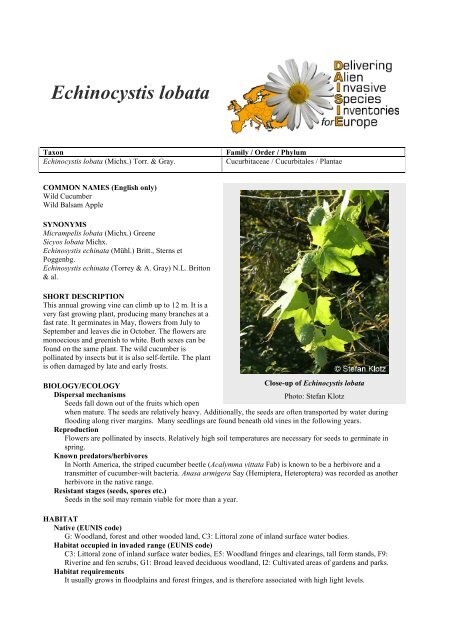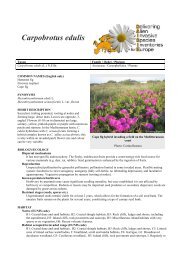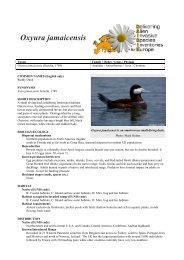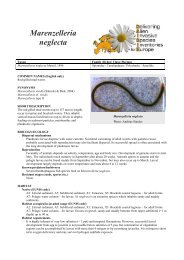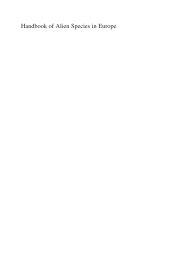Echinocystis lobata
Echinocystis lobata
Echinocystis lobata
Create successful ePaper yourself
Turn your PDF publications into a flip-book with our unique Google optimized e-Paper software.
<strong>Echinocystis</strong> <strong>lobata</strong><br />
Taxon Family / Order / Phylum<br />
<strong>Echinocystis</strong> <strong>lobata</strong> (Michx.) Torr. & Gray. Cucurbitaceae / Cucurbitales / Plantae<br />
COMMON NAMES (English only)<br />
Wild Cucumber<br />
Wild Balsam Apple<br />
SYNONYMS<br />
Micrampelis <strong>lobata</strong> (Michx.) Greene<br />
Sicyos <strong>lobata</strong> Michx.<br />
Echinosystis echinata (Mühl.) Britt., Sterns et<br />
Poggenbg.<br />
Echinosystis echinata (Torrey & A. Gray) N.L. Britton<br />
& al.<br />
SHORT DESCRIPTION<br />
This annual growing vine can climb up to 12 m. It is a<br />
very fast growing plant, producing many branches at a<br />
fast rate. It germinates in May, flowers from July to<br />
September and leaves die in October. The flowers are<br />
monoecious and greenish to white. Both sexes can be<br />
found on the same plant. The wild cucumber is<br />
pollinated by insects but it is also self-fertile. The plant<br />
is often damaged by late and early frosts.<br />
BIOLOGY/ECOLOGY<br />
Close-up of <strong>Echinocystis</strong> <strong>lobata</strong><br />
Dispersal mechanisms<br />
Photo: Stefan Klotz<br />
Seeds fall down out of the fruits which open<br />
when mature. The seeds are relatively heavy. Additionally, the seeds are often transported by water during<br />
flooding along river margins. Many seedlings are found beneath old vines in the following years.<br />
Reproduction<br />
Flowers are pollinated by insects. Relatively high soil temperatures are necessary for seeds to germinate in<br />
spring.<br />
Known predators/herbivores<br />
In North America, the striped cucumber beetle (Acalymma vittata Fab) is known to be a herbivore and a<br />
transmitter of cucumber-wilt bacteria. Anasa armigera Say (Hemiptera, Heteroptera) was recorded as another<br />
herbivore in the native range.<br />
Resistant stages (seeds, spores etc.)<br />
Seeds in the soil may remain viable for more than a year.<br />
HABITAT<br />
Native (EUNIS code)<br />
G: Woodland, forest and other wooded land, C3: Littoral zone of inland surface water bodies.<br />
Habitat occupied in invaded range (EUNIS code)<br />
C3: Littoral zone of inland surface water bodies, E5: Woodland fringes and clearings, tall form stands, F9:<br />
Riverine and fen scrubs, G1: Broad leaved deciduous woodland, I2: Cultivated areas of gardens and parks.<br />
Habitat requirements<br />
It usually grows in floodplains and forest fringes, and is therefore associated with high light levels.
DISTRIBUTION<br />
Native Range North America<br />
Saskatchewan and southwards to Texas.<br />
Known Introduced Range<br />
Temperate and continental Europe<br />
Trend<br />
There has been increasing invasion within the last twenty years along the main rivers, in floodplains from<br />
Western to Eastern Europe (up to the Asian border in Russia).<br />
MAP (European distribution)<br />
Known in country<br />
Legend<br />
Known in CGRS square<br />
Known in sea<br />
INTRODUCTION PATHWAY<br />
The plant was introduced in late 19 th and early 20 th century as an ornamental and medical plant and planted in several<br />
Botanical gardens. The first information on escaped plants is from Central and East Europe (1906 – Slovakia).<br />
IMPACT<br />
Ecosystem impact<br />
This vine branches very fast, covering large areas and overgrowing native vegetation. Its spatial occupation<br />
competes with native species.<br />
Health and Social Impact<br />
The plant contains toxic substances (cucurbitacines).<br />
Economic Impact<br />
Unknown.<br />
MANAGEMENT<br />
Prevention<br />
Planting as an ornamental plant in and near floodplains should be avoided.<br />
Mechanical<br />
Seedlings can be removed easily.<br />
Chemical<br />
Herbicide use is impossible in floodplain areas.
Biological<br />
Efficient biological control methods are not available.<br />
REFERENCES<br />
Hegi A (1929) Illustrierte Flora von Mitteleuropa. 6 (1): 497-544. J. F. Lehmanns. München<br />
Silvertown J (1985) Survival, fecundity and growth of Wild Cucumber, <strong>Echinocystis</strong> <strong>lobata</strong>. Journal of Ecology<br />
73:841-849<br />
Vasic O (2005) <strong>Echinocystis</strong> <strong>lobata</strong> (Michx.) Torrey et Gray in Serbia. Acta Botanica Croat. 64:369-373<br />
OTHER REFERENCES<br />
Kazinczi G, Horvath J, Hunyadi K (1998) Germination biology and virus susceptibility of wild cucumber<br />
(<strong>Echinocystis</strong> <strong>lobata</strong> Torr. et Gray). Novenytermeles 47(6):645-654<br />
Author: Stefan Klotz<br />
Date Last Modified: January 17 th , 2007


